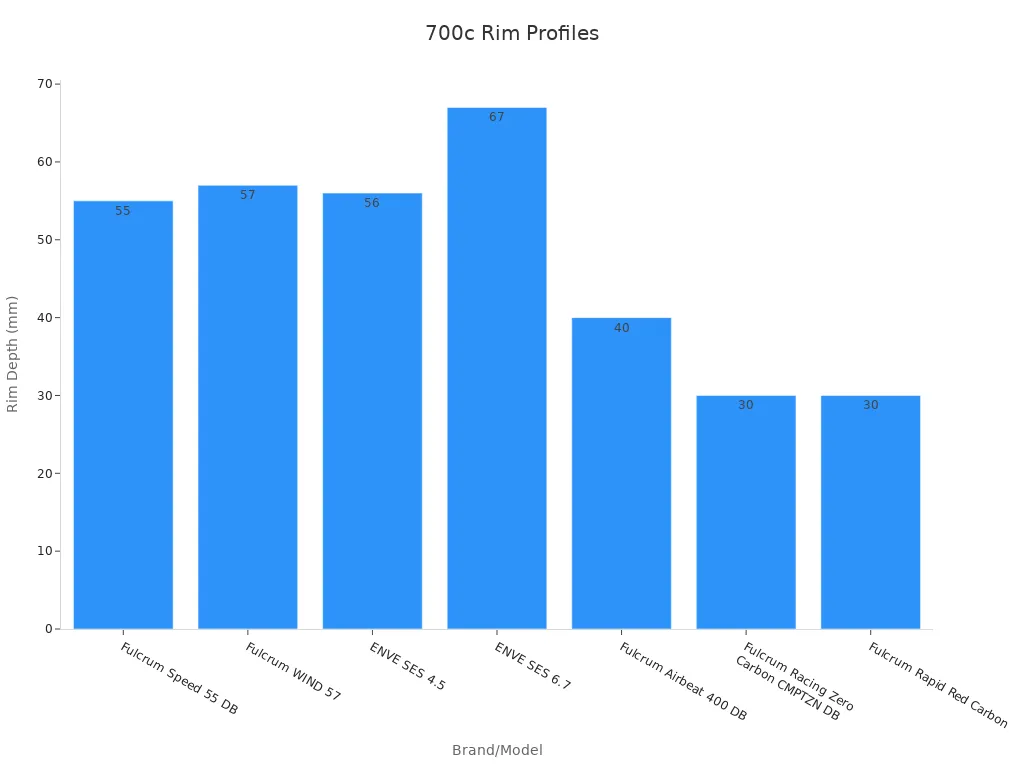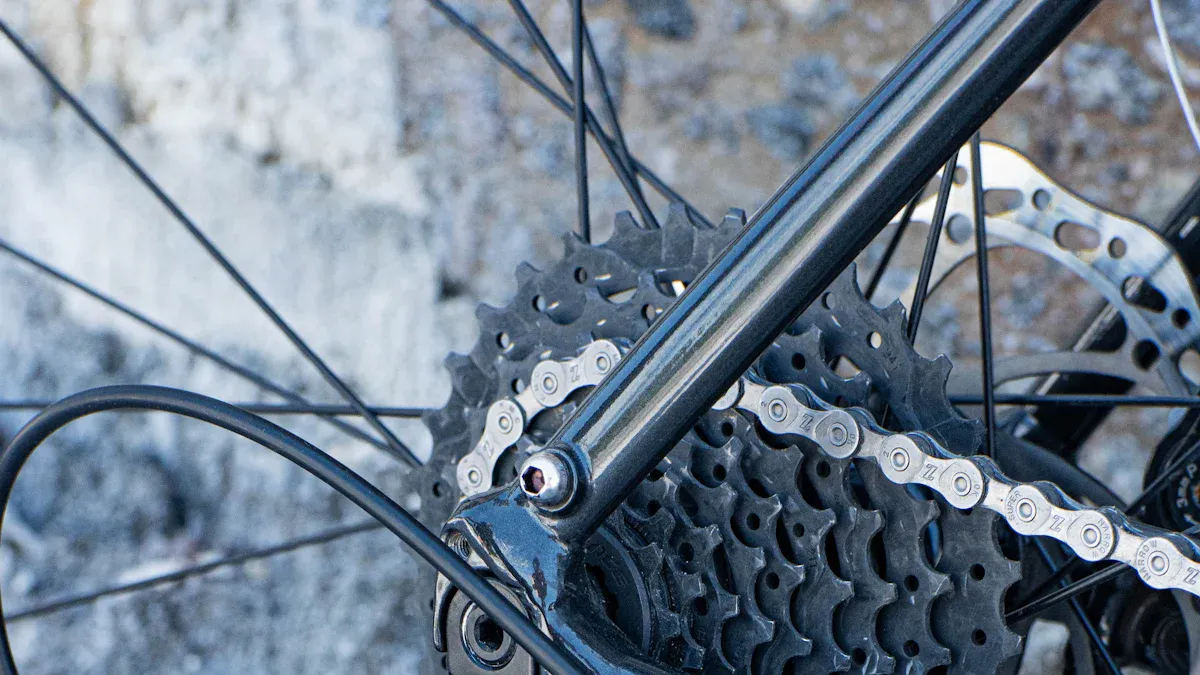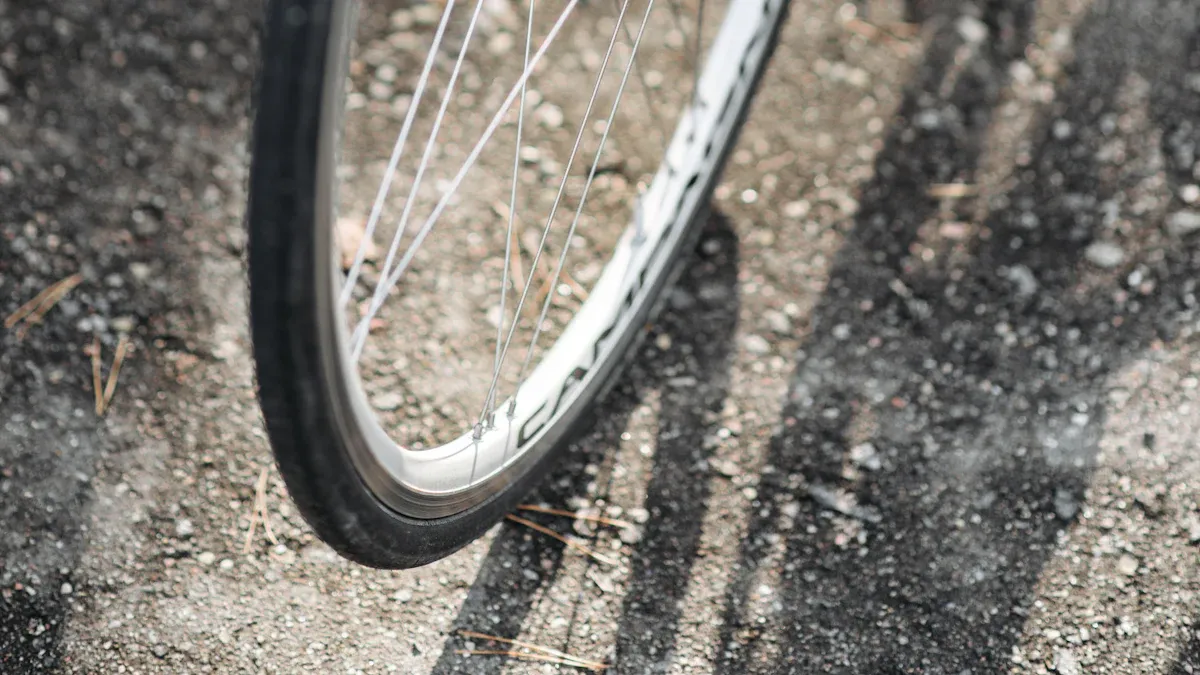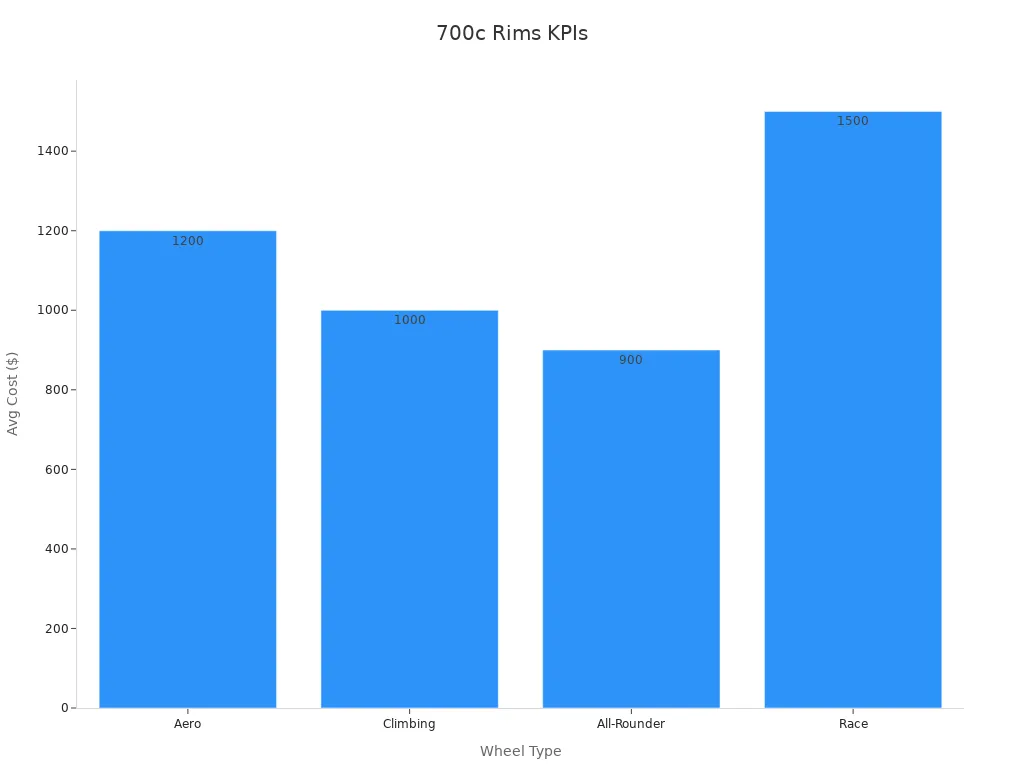You’ll see 700c rims everywhere in the road bike world. The “700c” label comes from an old French system, but today it means a rim with a 622mm diameter (ISO standard).
Most brands use 700c rims because they fit modern tires, boost speed, and work well with many bikes. Check out the table below—top brands use this size for their best wheels.

As you read, think about how rim size could affect your comfort, speed, and the kind of rides you want to enjoy.
Key Takeaways
700c rims have a 622mm diameter. They are the most common size for road bikes. They give a good mix of speed and comfort.
The 700c size started with an old French system. Now, it follows a worldwide standard. Many bike types use this size.
Rim depth and width change how your bike feels. Deeper rims help you go faster by cutting through air. Wider rims let you use wider tires. This gives more comfort and better grip.
Aluminum rims last a long time and do not cost much. Carbon fiber rims are lighter and faster. But they are more expensive.
There are three main rim types. Clincher rims are easy to fix if you get a flat. Tubeless rims get fewer flats and give a smoother ride. Tubular rims are the lightest but are harder to fix.
Make sure your new rims fit your bike’s hubs, tires, and brakes. This helps your bike work well and fit right.
Pick rims that match how you ride, where you ride, and how much you want to spend. This helps you get the best speed, comfort, and strength.
Clean your rims often. Keep them straight and check them for damage. This keeps your bike safe, smooth, and lasting longer.
1. What Are 700c Road Bike Rims

700c Meaning
ISO 622mm Diameter
When you look at a modern road bike, you’ll probably see 700c rims. The “700c” name actually points to a specific measurement. These rims have a bead seat diameter of 622 millimeters. This number comes from the ISO (International Organization for Standardization) system. You can find this size on almost every road bike, from speedy racers to comfortable touring bikes. The 622mm diameter helps your bike roll smoothly and keeps your ride stable. Over the years, tire widths for these rims have changed. Riders used to pick narrow tires, but now you’ll see wider ones for better comfort and grip.
French Sizing System
The story behind “700c” starts in France. Long ago, French bike makers used a system that measured the outer diameter of a tire in millimeters. The “700” meant the tire measured about 700mm across. The letter “C” showed the tire’s width, with “A” for narrow and “D” for wide. Today, the “c” mostly sticks around as a label, but the rim itself always measures 622mm. You might spot tire markings like “700x35C.” That means the tire fits a 700c rim and is about 35mm wide. This old system still shapes how we talk about bike wheels.
Fun fact: The 700c rim size isn’t just for road bikes. Hybrid bikes like the 2005 Giant Innova and even some mountain bikes (called “29ers”) use this rim size, showing how versatile it is.
Why 700c Is Standard
Road Bike Prevalence
You’ll notice that almost every road bike uses 700c rims. This size became popular because it balances speed, comfort, and tire choice. Bike makers found that 700c rims work well for racing, commuting, and long rides. You get a smooth ride and can pick from lots of tire widths. The switch from aluminum to carbon fiber rims also made 700c wheels lighter and faster, which helped them become the top choice for riders everywhere.
Comparison to Other Sizes
Other rim sizes exist, like 650c or 26-inch, but 700c stands out. Here’s why:
700c rims fit a wide range of tires, from skinny racing tires to wider gravel tires.
They help your bike keep momentum on smooth roads.
You’ll find more tire and rim options in bike shops.
The same 622mm diameter works for both road bikes and 29er mountain bikes, but the tires are different.
Bike designers also like 700c rims because they make it easier to build frames that handle well. The size affects how your bike steers and feels on the road. Over time, 700c rims became the standard because they offer the best mix of performance and choice for most riders.
2. Road Bike Rim Features
Dimensions
Rim Depth
Rim depth means how tall the rim is from where it meets the tire to the bottom edge. You will see rim depths from about 30mm up to 90mm. Deeper rims help you cut through the wind, so you go faster on flat roads. But, if you ride in windy places, deep rims can feel harder to control. Many riders pick a middle depth for a good mix of speed and stability.
Rim Width
Rim width matters for comfort and how your tire fits. Most road bike rims have an internal width between 19mm and 28mm. Wider rims let you use wider tires, which can make your ride smoother and help you grip the road better. If you use a rim that is too narrow or too wide for your tire, you might not get the best performance. Always check the tire and rim sizes to make sure they match.
Tip: Wider rims and tires let you use lower air pressure. This can make your ride more comfortable and help you roll faster on rough roads.
Here’s a quick look at key rim design features:
Materials
Aluminum
Aluminum rims are common and affordable. They give you a good balance of weight, strength, and price. Many riders like aluminum because it lasts a long time and handles bumps well. Some aluminum rims use special mixes, like adding silicon carbide, to make them even stronger and lighter.
Carbon Fiber
Carbon fiber rims are lighter and stiffer than aluminum. You will notice the difference when you pick up a carbon wheel. These rims help you go faster because they cut weight and improve aerodynamics. Makers use special molding methods to make sure the rims are strong and smooth. Carbon fiber rims cost more, but many racers and serious riders think they are worth it.
Other Materials
Some rims use mixes of materials, like aluminum with extra particles for more strength. These special rims can be lighter and tougher than regular aluminum. You might see these on high-end bikes or in racing.
Design
Aero vs. Box Section
You will find two main rim shapes: aero and box section. Aero rims have a deep, rounded shape that slices through the wind. These are great if you want to go fast, especially in races or time trials. Box section rims look more like a simple rectangle. They are lighter and easier to handle, especially if you ride in windy places or on hills.
Weight Considerations
Weight matters when you ride up hills or want to speed up quickly. Lighter rims make your bike feel snappier. Carbon fiber rims are usually the lightest, but some aluminum rims come close. If you want the best mix of speed and control, look for a rim that balances weight, strength, and the right shape for your rides.
Note: The right rim design can help you ride faster, feel more comfortable, and stay in control, no matter where you ride.
3. Types of 700c Rims

When you shop for wheels, you’ll see three main types of 700c rims. Each type has its own structure, benefits, and drawbacks. Let’s break them down so you can pick what fits your riding style.
Clincher
Structure
Uses a separate tire and inner tube.
The tire hooks onto the rim’s bead, holding everything in place.
Most common rim type for everyday riders.
Pros and Cons
Tip: Many clincher rims now come “tubeless ready,” so you can upgrade later if you want.
You’ll find clincher rims everywhere because they’re easy to fix and work for most rides. If you get a flat, you just swap out the tube and keep rolling. These rims fit lots of tire sizes, so you can ride on pavement, gravel, or even cyclocross courses. Some high-end clincher wheels use carbon fiber for lighter weight, but most are still a bit heavier than other types.
Tubeless
Setup
No inner tube needed—just a special tubeless tire and rim.
You add liquid sealant inside the tire to seal small punctures.
The tire locks tightly to the rim, creating an airtight seal.
Pros and Cons
Tubeless rims have become popular for riders who want fewer flats and a smoother ride. You can run lower air pressure, which means more grip and comfort, especially on rough roads. Studies show tubeless tires roll a bit faster than clinchers—just a few watts, but every bit counts if you love speed. You’ll need to check the sealant every few months, and bigger punctures might still need a tube. If you like to tinker and want top performance, tubeless could be your best bet.
Note: Tubeless tires shine in wet or bumpy conditions, giving you better traction and fewer worries about flats.
Tubular
Compatibility
Tire and tube are sewn together into one piece.
You glue the tire directly onto a smooth rim bed—no bead hooks.
Only works with tubular-specific rims.
Pros and Cons
Tubular rims are the top choice for pro racers. You glue the tire on, so it stays put even at high speeds. These rims let you run high pressures, which means less rolling resistance and better cornering. If you get a flat, the tire usually stays attached, so you can slow down safely. But gluing tires takes time and practice, and fixing a flat on the road is tough. Most everyday riders skip tubulars, but if you race and want every advantage, they’re worth a look.
Callout: Tubular rims give you the best performance in races, but they need more care and skill to use.
4. Compatibility
When you pick new 700c rims, you need to make sure they work with your bike’s hubs, tires, and brakes. Let’s break down what you should check for each part.
Hubs
Axle Standards
You’ll find different axle standards on modern bikes. Here’s what you need to know:
Most new 700c wheels use 12mm thru-axles (100mm wide in the front, 142mm in the back). These are strong and work best with disc brakes.
Some older bikes use quick-release skewers (9mm). If you have one of these, look for wheels with convertible end caps so you can fit your frame.
Freehub bodies must match your cassette. Many brands let you swap freehub bodies to fit Shimano, SRAM, or Campagnolo cassettes.
Tip: Always check your bike’s axle type before you buy new wheels. This saves you from headaches later!
Spoke Count
The number of spokes affects how your wheels feel and last.
Carbon rims often use fewer spokes (like 24) because they are stiffer than aluminum.
Straight-pull spokes and special lacing patterns (like 2:1 or X2) can make wheels lighter and stronger.
Offset spoke holes help balance tension, so your wheels stay true longer.
You get a stiffer, more reliable wheel when the hub and spoke count match your riding style.
Tires
Width Range
Tire width must fit your rim and your bike frame. Here’s a quick guide:
Minimum tire width = rim inner width × 1.45
Maximum tire width ≈ rim inner width × 2
If your rim is 19mm wide inside, you can use tires from about 28mm to 38mm. Always check your frame clearance so the tire doesn’t rub.
Wider tires give you more comfort and grip, especially on rough roads. Narrow tires roll faster on smooth pavement.
Tubeless vs. Tubed
Hooked rims work with all clincher and tubeless tires (with or without tubes).
Hookless rims need ETRTO-approved tubeless tires only. Don’t use regular clinchers on hookless rims.
Tubeless setups let you run lower pressure and get fewer flats, but you need to check the sealant and tire fit.
Brakes
Rim Brakes
Rim brake wheels have a flat, machined surface for the brake pads.
These wheels are lighter and simple to maintain.
You need to match rim width to your brake calipers and frame.
Disc Brakes
Disc brake wheels have no braking surface on the rim. The brake grabs a rotor at the hub.
These wheels are a bit heavier but last longer since the rim doesn’t wear out from braking.
Disc brakes let you use wider tires because there’s no caliper to limit space.
Note: You can switch rim brake wheels to disc if your frame and hubs allow it, but you can’t use disc brake wheels with rim brakes.
5. Choosing and Maintaining 700c Rims
Choosing Rims
Picking the right 700c rims can feel tricky, but you can break it down into a few simple steps. Let’s look at what matters most.
Riding Style
Racing: If you love speed and want to race, go for lightweight carbon fiber rims. These rims help you accelerate fast and keep your bike light. Tubular tires work well for racing, but clinchers and tubeless setups are also popular.
Commuting: For daily rides to work or school, you need strong and reliable rims. Aluminum rims with more spokes handle bumps and heavy loads better. Clincher tires make fixing flats easy.
Adventure or Gravel: If you ride on rough roads or trails, pick wider rims that fit wider tires. This gives you more grip and comfort. Tubeless tires help prevent flats and let you use lower air pressure.
Tip: Always match your rim width to your tire width. This keeps your ride stable and safe.
Terrain
Smooth Pavement: Narrower rims and tires roll faster and feel lighter. These work best for city streets and smooth bike paths.
Rough Roads or Trails: Wider rims and tires give you better control and comfort. Look for rims that support tires at least 28mm wide.
Hilly Areas: Lightweight rims help you climb hills with less effort. Carbon fiber rims shine here, but strong aluminum rims also work well.
Budget
Entry-Level: Aluminum rims cost less and last a long time. They are perfect for new riders or anyone who wants a good deal.
Mid-Range: Some rims mix aluminum with special materials for extra strength. These give you a balance of price and performance.
High-End: Carbon fiber rims cost more but offer the best speed and lightness. If you race or want top performance, these are worth a look.
Maintenance
Keeping your 700c rims in top shape helps you ride safely and smoothly. Here’s how you can do it:
Cleaning
Wipe your rims with a damp cloth after every few rides.
Remove dirt and brake dust to stop wear.
Use mild soap if your rims get really dirty.
Truing
Check if your wheels spin straight. If they wobble, they need truing.
Tighten or loosen spokes to fix small wobbles. You can learn this from online videos or ask a bike shop for help.
Regular spoke checks keep your wheels strong and safe.
Replacement
Inspect your rims for cracks, dents, or deep grooves.
Replace rims if you see big damage or if braking feels weak.
Change brake pads often to protect rim surfaces.
Note: Keeping your rims clean and true helps you ride faster and safer. Regular checks also make your road bike last longer.
You’ve seen how 700c rims boost speed, comfort, and control.
Double-wall aluminum rims, like those on the Hiland 700C, add stability and safety.
Lighter wheels help you climb faster, while wider rims improve handling.
Each wheel type offers a different balance of cost, performance, and durability.

Try different rims or ask your local shop for advice.
Keep your wheels clean and true for the best ride every time.
FAQ
What does “700c” actually mean?
“700c” means the rim has a 622mm diameter. The “c” comes from an old French system. Today, you just need to know that 700c is the standard size for most road bikes.
Can I use wider tires on my 700c rims?
Yes, you can use wider tires if your rim and bike frame allow it. Check your rim’s internal width and your bike’s clearance. Wider tires give you more comfort and grip.
Are carbon fiber rims worth the extra money?
If you want a lighter and faster ride, carbon fiber rims help. They cost more, but you get better speed and performance. For daily riding, aluminum rims work great and save you money.
How do I know if my rims need replacing?
Look for cracks, dents, or deep grooves. If your braking feels weak or your wheels wobble, it might be time for new rims. Regular checks keep you safe.
Can I switch from rim brakes to disc brakes with my 700c wheels?
You can only switch if your bike frame and wheels support disc brakes. Disc brake wheels have special hubs and no braking surface on the rim. Always check your bike’s specs first.
What’s the difference between clincher, tubeless, and tubular rims?
Clincher: Uses a tire and tube. Easy to fix flats.
Tubeless: No tube. Needs sealant. Fewer flats.
Tubular: Tire is glued on. Lightest for racing, but hard to repair.
Tip: Most riders use clincher or tubeless rims for everyday cycling.


